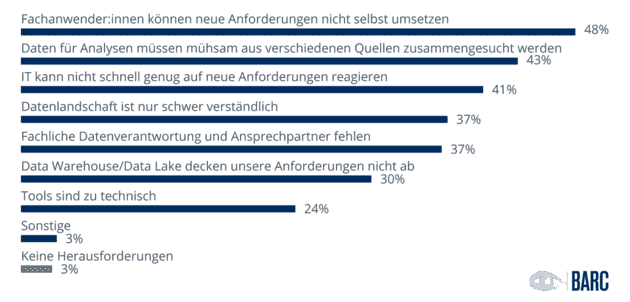Press Release: Centralized Data Architectures on the Way Out?
BARC (Business Application Research Center) releases the results of its new topical survey The Future of Data Architecture – Has the Data Warehouse Had Its Day? This survey-based report offers insights into today’s most promising data architecture and data modeling approaches. The study is available for download free of charge thanks to sponsorship by Precisely, TimeXtender, Denodo and Databricks.
- Key Finding #1: The most successful companies favor the data lakehouse approach
- Key Finding #2: Business user empowerment must go to the next level
Centralized vs. decentralized
Most companies continue to apply tried-and-tested concepts such as the data warehouse design paradigm for their data landscapes. Best-in-class companies favor the data lakehouse approach. However, executives and business users in particular criticize the fact that centralized approaches cannot prevent the emergence of further data silos.
“We recommend that companies work towards a federated overall architecture in which data virtualization and distributed data pipelining and orchestration are options and the framework for this is in place,” said Jacqueline Bloemen, Senior BARC Analyst and co-author of the report. “As the quantity and volume of distributed data sources increase, data architecture concepts that are exclusively centrally oriented quickly reach their limits.”

© BARC 2022
Business user empowerment must go to the next level
Providing self-service analytics tools to the business has picked up speed, and only a minority of users finds that the tools available to them are too technical. However, the data landscape is a limiting factor in many cases. Because data warehouses frequently do not meet business needs, data for analysis must be tediously gathered from various sources. But still, initiatives in the direction of a data catalog – including suitable data documentation and self-service data preparation – are not widespread.
“Best-in-class companies realize the importance of enabling business users to work with data as and when required,” said Timm Grosser, Senior BARC Analyst and co-author of the report. “However, they do not always support this properly, for example, by providing the right data documentation and the appropriate tools. Data & analytics teams must embrace this reality and shape it more consciously in the future.”

© BARC 2022
About the survey
BARC (Business Application Research Center) is one of Europe’s leading analyst firms for business software, focusing on the areas of data, business intelligence (BI) and analytics, enterprise content management (ECM) and customer relationship management (CRM). The company was founded in 1999 as a spin-off of the Chair of Business Administration and Information Systems at the Julius-Maximilians-University in Würzburg. Today, BARC combines empirical and theoretical research, technical expertise and practical experience, including a constant exchange with all market participants.
